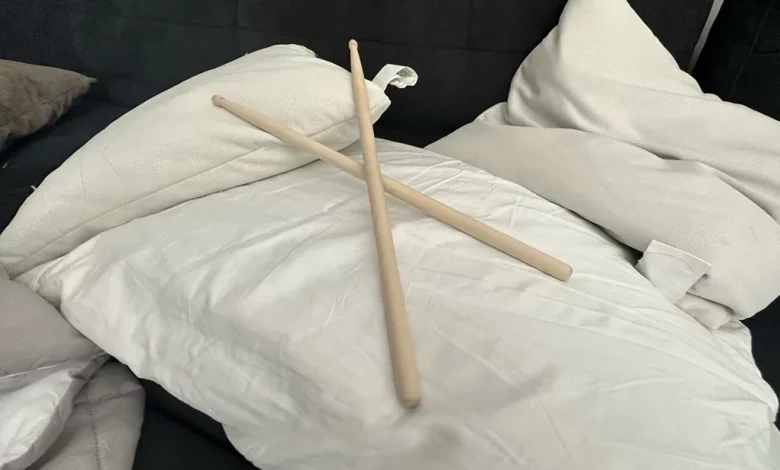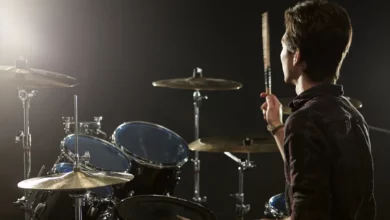
We may earn a commission from the affiliate links on this site. Learn more›
Drumming is a form of art that has been around for thousands of years, providing a way for people to express themselves musically and connect with others. While drums are often seen as the quintessential instrument, it is possible to create rhythm and beats without them by using your own body.
Since the dawn of time, man has used body movements such as tapping his feet or clapping his hands to the beats of songs and music. This means body percussion dates back to the prehistoric era with a strong biological, social, and anthropological foundation.
This form of drumming, known as body percussion, is an innovative and accessible way to experience the joys of drumming without the need for expensive equipment or a dedicated practice space.
What is Body Percussion, and How Can You Do It?
Getting started with body percussion is easy. The first step is to experiment with the different sounds that your body can produce. Clapping your hands, slapping your thighs, snapping your fingers, and stomping your feet are all great starting points. As you experiment, you will start to develop a rhythm that feels natural and comfortable to you.
It is essential to focus on developing your sense of rhythm as you explore body percussion. One of the best ways to do this is by practicing with a metronome or other rhythmic instrument.
This will help you internalize the beat and develop your ability to keep time. In addition, try to listen to music and play along with the beat, building your musical instincts and improving your timing.
What Are The Best Ways To Practice Drums Without The Drums
Practicing the drums will be much simpler if you have a drum set or kit. If such is not the case, though, all is not lost. Simply consider these options if you don’t have any drums:
Use Pillows
No drum kit? No problem! The thing you use each night to sleep could be great for practicing pad drumming. Unfortunately, your wrist has to work to lift the stick and lower it because a pillow doesn’t provide any bounce.
So the best approach to hone those fundamentals is to practice drumming on your pillow.
Using this technique, you can practice your time, rudiments, and other skills. The best aspect is that it is silent; you can practice till the early morning hours without disturbing your neighbors.
Thanks to this method’s simplicity, you may quickly transfer what you have been practicing on your pillow to your drum set (all you really need are some drumsticks).
Air Drumming
Playing on an imaginary drum set or air drum is an excellent approach to practicing drums and developing your muscles. However, compared to playing real drums or a practice pad, this drumming style requires you to use your physical strength.
Most likely, you have performed this many times previously. Even before they thought about taking classes, everyone had performed some sick fictitious air riffs and rolls. However, air drumming involves more than simply imagination.
Air drumming produces little to no sound, making it a fantastic option to practice away from your set. Additionally, the exercise’s repetitive movements will aid in committing crucial foundational information to memory and will be beneficial for strengthening your arms!
With today’s technology, there are more methods to spice up your air drumming.
Use Practice Pads
Drummers can rehearse without their set with the use of practice pads. These frequently have a variety of surfaces that are designed to concentrate on honing particular skills.
For instance, a practice pad’s top portion has a rebound that resembles a drum head. By practicing on it, you may sense how it will feel when you perform a particular song on your set. The pad’s sides are ideal for practicing rim shots as well.
A softer substance makes up the pad’s back. With less rebound than cushion practice, this accomplishes the same goal of strengthening and conditioning your muscles. Others come loaded with sand, gel, or just about any rubber you can think of.
If you don’t have a conventional rubberized pad, fetch some pot holders from the kitchen, then start working.
You can rehearse all night without worrying about your neighbors because they often don’t make loud noises.
Using Mobile Games and Apps
This is a great way to practice drumming if you enjoy playing, especially drumming rhythm games. Rock Band (3) and other rhythm games can aid you with timing. Additionally, depending on the game you play, it might assist you in improving your hand-eye coordination, which will be very helpful while playing on an actual drum set.
Online drum classes are another option if you’d prefer a more in-depth practice. You can even download drumming apps, as some contain practice lessons and activities designed to teach the fundamentals of drumming to new drummers.
Utilize Body Percussion
Although it might sound absurd, practicing the drums by playing the rhythms on your body is terrific. Body percussion facilitates practice and gives you a sense of the beat. Try using a set of keys or loose change for a more snare-like sound.
Use anything you can find to practice drums, such as spoons, hangers, jingle bells, coin sacks, etc. Enjoy yourself, and use your creativity!
You can even use specialized percussion instruments to ratchet, hit, or shake. Use tambourines, jingle bells, or even items from your kitchen drawer for a DIY solution.
Make A Drum Yourself
Of course, you could make your own if you’re searching for the least expensive way to learn how to drum! You’ve probably witnessed street performers using a variety of repurposed items to create percussion instruments, including pots and pans, pipes, or even buckets.
Why Should You Learn Drums Without Drums?
Most new players believe they need drums to practice the instrument. However, that is only sometimes the case.
If you’re still saving up for a drum set, you’ll be happy to know that you can begin practicing before you even buy one. Additionally, practicing without a drum set will help you hone abilities that are more difficult to master when using one.
It may even prove to be more effective than practicing on actual drums. In actuality, it can be challenging to get used to just one pair. Therefore, you will have a few different drum setups you will use as a drummer.
You can find adjusting to a new set challenging after becoming accustomed to one. Instead of getting used to a particular drum set, the ideal approach for this is to become familiar with the motions of playing the drums.
In particular, Doing this can improve your abilities without being constrained by the drum set you are playing.
Top 4 Benefits of Body Percussion
Training without drum equipment is quite advantageous for your health and skill development. Here, we discussed four primary benefits of body percussion:
Strengthens Muscle Memory
Rhythmic patterns are repeated when drumming. As a result, many people feel pressured to perform at a specific tempo or speed when practicing on a set. However, it is preferable to begin slowly and build up to a higher tempo to improve muscle memory more quickly.
When you practice apart from a set, the pressure of playing at a moderate pace is removed, allowing you to concentrate on hitting the targets. According to science, it also stimulates our cognitive processes and thus improves memory, learning, and concentration capabilities.
Get Your Timing Right
You already know how the sound of your drumming can overpower your music if you’ve tried to practice drumming by copying the beat of a song. This could make it more challenging to determine the timing of each beat or perhaps miss them entirely.
Using your body or other materials can help set timings more precisely. Drummers must be exceptionally adept in timing. But it can be challenging, especially for newcomers. If you are experiencing problems, you should isolate this drill and concentrate solely on timing. You’ll also be able to master time more quickly if you do this.
Work On Your Rudiments
The value of studying and using drum rudiments still needs to be determined. Of course, it cannot be disputed; nevertheless, being aware of them makes it easier for you to get comfortable with the various ways drumming can help you express your emotions. In addition, rudiments aid in developing crucial drumming abilities like fluidity, articulation, precision, and a host of others.
Because no other surface has the same bounce as a drum, practicing rudiments off a set also helps you develop your strength. This allows you to build stamina and offers you a perfect workout.

Relieves Stress
Drumming, especially body percussion, can have several health benefits. It is a form of self-expression that helps you release your energy blockages and flush out negative emotions from your body. Drumming releases endorphins in your brain, which are generally associated with well-being and happiness.
In addition, it can help you de-stress and boost your immune system. According to a study, group drumming induced the production of T-cells in the body that helps combat severe illnesses like cancer and AIDS.
Conclusion
If you know where to look, you can find percussion instruments and, by extension, drumming kits in everything around you.
But, of course, if you’re a skilled drummer, you probably already know this because you’ve occasionally seen yourself tapping your foot to the rhythm or using your hands to drum a melody on a table or other surface.
It’s comforting to know that there are no obstacles to learning how to drum. Whether body percussion appeals to you, you can learn to drum virtually or repurpose everyday objects.



